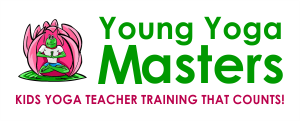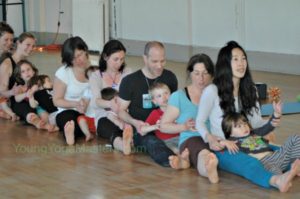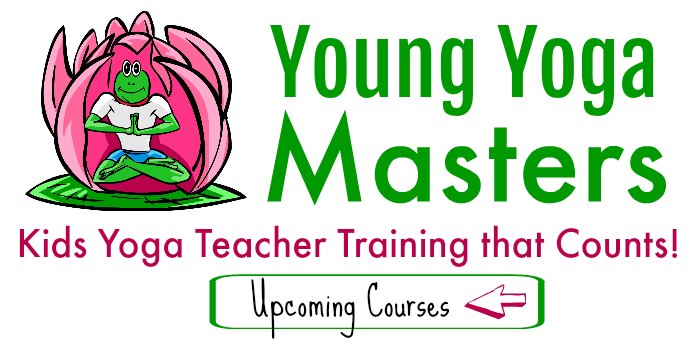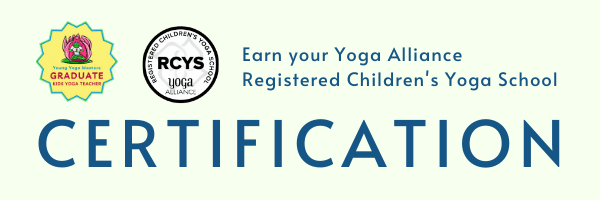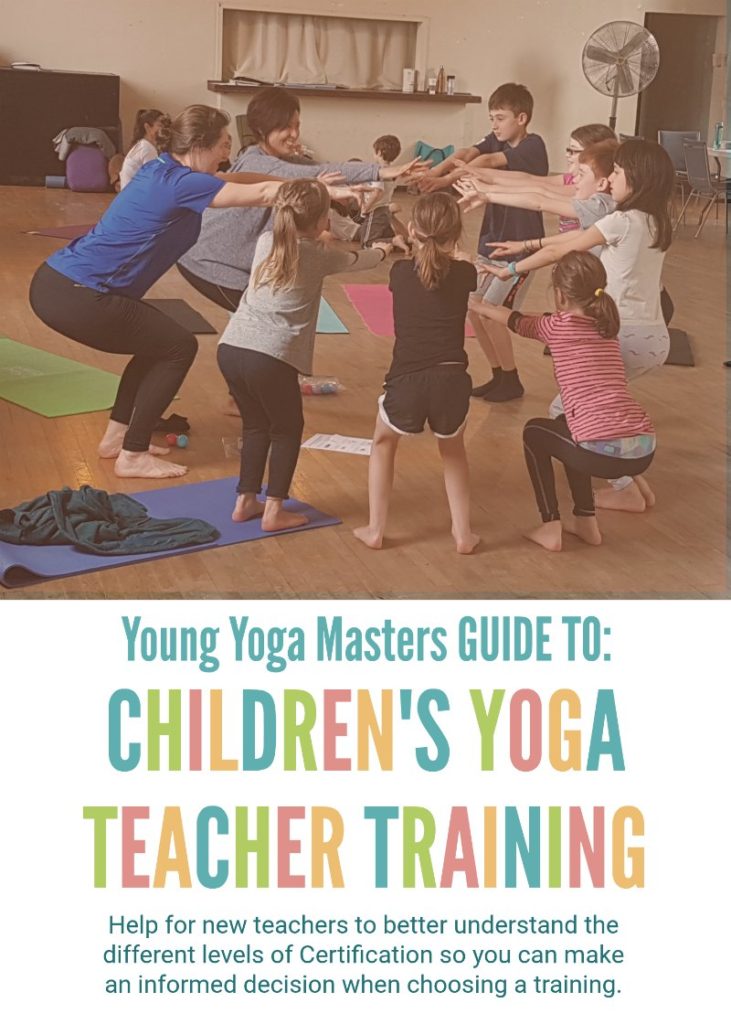
Your Guide on the Path to Teaching Yoga to Children
Navigating your way to becoming a Kids Yoga Teacher can be confusing. Young Yoga Masters’ offers you this Guide with 6 important factors to consider so you can make an informed decision when choosing a training. With over 20 years experience teaching yoga, Young Yoga Masters has extensively researched the range of qualifications you can achieve.
The guide can help you choose the right training for your teaching goals and help you avoid starting from the beginning should you eventually want to get the highest level of qualifications.
How to Become a Kids Yoga Teacher
6 Important factors to consider when becoming a kids yoga teacher. Each is covered in more detail in the article below.
- Your Personal Practice of Yoga: To teach anything, you must have a personal experience and understanding of the subject. If you want to teach kids yoga, make sure you also practice yoga yourself so you can embody the benefits of yoga as a teacher.
- Government Regulations for Kids’ Yoga Teachers: Many people want to know who is allowed to teach yoga and are surprised to find out that teaching yoga is not regulated by government.
- The Levels of Certification for Children’s Yoga Teachers: Understanding the various levels of certification and standards set by the yoga industry itself is key before you choose a training.
- Your Teaching Goals: Choose a training to help you reach your goals and qualify you to teach where and how you want to teach.
- Will you need Insurance? You will want to be protected if you are going out and teaching in public so find out what certificates the insurance providers require.
- Train for Your Learning Style: Choose a training that you will enjoy and actually complete to earn the certificate.
Considering these factors before choosing a training can save you problems in the long run. Read on to see why.
Guide to Becoming a Children’s Yoga Teacher:
Here is the Young Yoga Masters’ Guide to 6 important factors in becoming a kids yoga teacher and our recommendations too.
1. Your Personal Practice of Yoga
To teach anything, you must have some level of personal experience with the subject. If you are considering teaching yoga to children, develop your own personal practice of yoga so you can teach from experience as well as what you study.
Consider keeping a journal after each yoga asana practice or meditation. Write down your thoughts and feelings after doing a yoga class in a studio, online, or from a book. Include poses you enjoyed, ones you found difficult, and teaching cues and stories as well. Your journal will be useful to look back on as you begin teaching others, it will help you recall how you felt and how your students may feel as they begin the exploration of yoga.
2. Government Regulations for Kid Yoga Teachers
Many people ask, “Who is allowed to teach yoga?”
They are often surprised to find out that at this time, there are no government regulations on who can teach kids yoga and who cannot. Some states and regions have attempted to license and regulate yoga teacher training. Organizations like Yoga Alliance have worked to keep yoga a self-regulated industry.
We recommend you do a quick internet search of “Yoga Teacher regulations REGION/COUNTRY” to double check if your region has implemented new regulations.
If there are no regulations, you could actually start teaching yoga right now and not be breaking any laws.
From here, the question shifts to whether you know what to do to teach yoga to children. Understanding the other factors for becoming a Kids Yoga Teacher is the next step.
3. Understanding the Various Levels of Certification for Children’s Yoga Teachers
There are various levels of certification and different organizations that have created standards for teaching yoga and becoming a children’s yoga teacher.
Arguably, the largest and most recognized is Yoga Alliance (YA), which sets standards and maintains a registry of yoga teachers from countries around the world who voluntarily meet these standards. Although Yoga Alliance is based in the USA, they are an international registry.
Here are the various levels of certification compared to the Yoga Alliance standards:
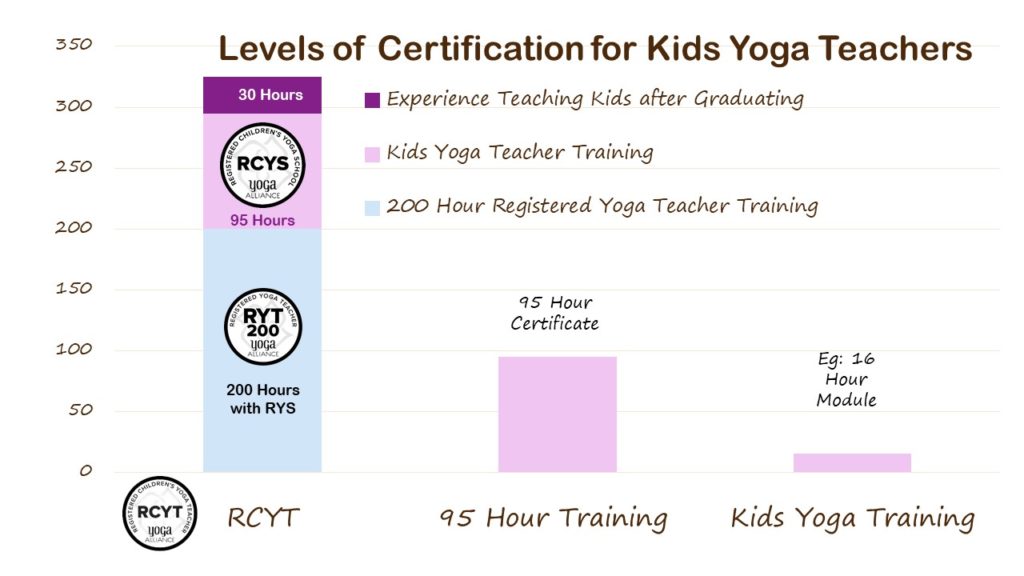
To achieve the Registered Children’s Yoga Teacher (RCYT) designation with Yoga Alliance you need all of these certifications:
- 200 Hour Adult Yoga Certificate from a YA Registered School,
- 95 Hour Children’s Yoga Certificate from a YA Registered Specialty School*,
- 30 Hours experience teaching children’s yoga after you complete your training.
This represents the highest industry standards at this time. However, without government regulations for teaching yoga, meeting these standards is voluntary.
You will want to consider your teaching goals when choosing which level of certification to achieve.
Many teachers earn their Children’s Yoga Teacher Certificate first then go on to get their 200 Hour Adult Teacher Certificate and register with Yoga Alliance.
Some teachers don’t register with Yoga Alliance at all and take various children’s yoga training courses or other courses based on their interests, especially those who don’t ever want to teach adults or become trainers.
However, we have had several people take our training who already have a lot of experience teaching children, but don’t have the 95 Hour Certificate. Why? They are ready to be a trainer and want to be a trainer in a Yoga Alliance Registered school, and they can’t do that without the Yoga Alliance Certificate. So if you are choosing between training, you may want to choose a YA registered training from the start so you have that option open to you.
4. The Level of Training for Your Teaching Goals
Now that you understand that training is not mandated but voluntary, and that there are industry standards, you can consider the level of training you need for your goals as a teacher.
- Teaching Informally: If you see yourself teaching your own children in your own home, you can learn some tools with a shorter training in a topic that interests you or even from books about kids yoga. Then start teaching your own kids.
- Teaching as a Added Activity: If you see yourself adding yoga to another activity, like in your classroom or daycare, or as a coach or community leader (eg: school, daycare centre, Girl Guides), I recommend taking modules with a Children’s Yoga Training school that will eventually earn you your 95 Hour Certification*. You can start teaching what you have learned after each module. When you want new ideas you can take another module, and eventually earn your 95 Hour Certificate.
- Promoting Yourself as a Kids Yoga Teacher: If you see yourself actively promoting yourself as a Kids Yoga Teacher, you will likely want a significant amount of training for your resume. I recommend a minimum 95 Hour Certificate* and keeping your eye on the 200 Hour Adult Yoga Teacher Certificate* as well so you can eventually earn the full RCYT designation. It is not mandatory, but you want to feel proud of your training, and this one will be the highest in the industry.
* Note: to earn a 95 Hour Certificate all 95 hours of training must be taken with the same Registered Children’s Yoga School (RCYS). Yoga Alliance does not allow you to combine training from different schools. This is because each RCYS has submitted a curriculum that fulfills specific hours of learning in the various categories. For example, a training must include 18 practicum hours, observing your trainers and learning from other students’ teaching, and with you teaching children as a lead trainer for 4 hours. If you combine training from different schools you do not know if this requirement was fulfilled. Taking a number of trainings with different schools until you reach 95 hours of training will NOT qualify you for the 95 Hour Certificate because all hours need to be with one YA registered school.
5. Will You Need Insurance?
Depending on your teaching goals you may need insurance to cover you in the case of accident or injury. Each insurance company has a different number of training hours required to insure a teacher. If you are working in a school or daycare you likely have insurance coverage for yourself as a teacher. In other settings you may be responsible for your own insurance, so ask other teachers in your region who they use for insurance and call the company to find out what training certificates you will be required to hold. The hours of training required vary from company to company, typically between 40 hours of children’s yoga training to the full RCYS designation outlined in #3 above.
6. What Training Works for Your Learning Style
Once you choose the level of certification you want to achieve, the next step is choosing a training you will enjoy and complete successfully.
Whether a training is live (synchronous), completely self-paced (asynchronous), or a blend of these, each person has a way that they learn best.
At one time, Yoga Alliance required in-person (contact hours) for yoga teacher training, but the pandemic changed that. Now you have a lot of options to learn the way you like which include:
- self paced learning that is pre-recorded and on demand,
- real time learning or live virtual (zoom) learning with a fixed start and end time that is interactive,
- live real time webinars with chats and Q + A,
- breakout sessions with peers facilitated by your trainers,
- live feedback from your trainers on your practicum classes.
Recommendations: Look back on the courses that you have signed up for in the past. Which ones did you enjoy the most? How were they offered? Which ones did you never finish? How were those ones offered? This will give you a good indication of the learning style you prefer so you can choose a course you will actually enjoy and complete.
Do you want a handy version of this guide? Click the button below to download the PDF Guide.
Know the Requirements before Becoming a Kids Yoga Teacher
Young Yoga Masters has been a Registered Children’s Yoga School since 2012 and we have seen how much the standards have changed over the years and with covid. You have more options for training now than ever before.
However, we regularly have teachers sign up for our training because the training they took was not registered with Yoga Alliance. They didn’t think it mattered but as they moved on in their teaching it became more important for insurance discounts or to offer their own teacher training.
We hope this guide helps you better understand the factors for choosing a training.
If you are thinking of Training…
If you are thinking of taking a children’s yoga teacher training, we hope you consider Young Yoga Masters. You have a range of training options from free mini-training and affordable resources to give you a taste of our style, the full Teacher Training with our Yoga Alliance Registered Children’s Yoga School, we also offer the 200 Hour Yoga Teacher Training, and can even help you become a Teacher Trainer when you qualify.
No matter which Level of Certification you are looking for, we hope you choose Young Yoga Masters to mentor and support you on your path. We’d love to see you grow your yoga teaching skills with us, whether you’re looking for a few activities to get started in your classroom or living room, or have bigger dreams of a part-time, full-time, or next career teaching Yoga to kids.
If you still have questions about the various levels of certification you can email us at: [email protected]
